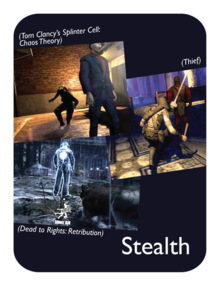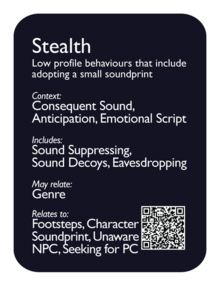Stealth

|

| |
| The card's front face | The card's back face |
Contents
Synopsis
| Low profile behaviours that include adopting a small soundprint. |
Relationships
Context:
Consequent Sound ![]() , Anticipation
, Anticipation ![]() , Emotional Script
, Emotional Script ![]() .
.
Includes:
Sound Suppressing ![]() , Sound Decoys
, Sound Decoys ![]() , Eavesdropping
, Eavesdropping ![]() .
.
May relate:
Genre File:M385px-Genre-front-v20.png.
Relates to:
Footsteps ![]() , Character Soundprint
, Character Soundprint ![]() , Unaware NPC
, Unaware NPC ![]() , Seeking for PC
, Seeking for PC ![]() .
.
Description
Sound plays a special role in Stealth actions: the sound associated to the PC's actions (including moving) is relevant for the Gameplay (that is, Consequent Sound), namely in terms of the reaction of the NPC.
Being able to perfor Stealth implies that it is relevant to perform low profile actions, in order to avoid unwanted attention; and, sound can be used as tool to overcome opponents.
Besides the explorations calling for low profile actions in order to avoid unwanted attention, sound can also be used as tool to overcome opponents. Two examples are the use of Sound Decoys and Eavesdropping.
Regarding the first intent sound can be designed in a way that the Character Soundprint depends on the magnitude of the movements. Footfalls, in particular are usually explored with that purpose. Sounds that result from characters actions are also relevant, as inspired by Coherence, like the common case of gun shots. Also it is interesting to include elements in the gameplay that allow Soundprint Suppressing. For the latter intent other explorations exist such as, Decoys, Eavesdropping, etc.
Examples






